Advertisements
Advertisements
प्रश्न
Explain the effect of change in prices of the related goods on demand for the given good.
उत्तर
Effect of change in price of related goods:
i. Demand for a commodity in relation to price of the substitute good When the price of one good falls, it becomes cheaper in relation to another good. As a result, one good is substituted for the other good such as coffee and tea. Assume tea and coffee are two substitute goods. D1 is the demand curve for the demand of tea in diagram (a).
Increase in price of substitute good:
When the price of tea is OP1, the quantity demanded is OT1 as shown in diagram (a). If there is an increase in the price of the substitute good coffee, then the demand curve for tea shifts to the right. Now, the consumer is willing to buy P1C2 quantity of tea which is equal to OT2. Greater the purchase of a commodity at its constant price points to a situation of increase or forward shift in the demand curve. The consumer demand curve shifts from D1 to D2, consuming more of tea even when its price is constant.
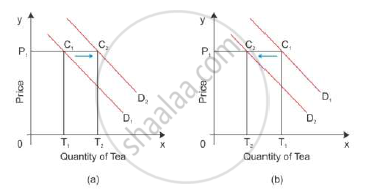
Decrease in price of substitute good:
When there is a decrease in the price of the substitute good coffee, the demand curve for tea shifts to the left even when its price is constant. When the price of tea is OP1, the quantity demanded is OT1 as shown in the diagram (b). Now, the consumer is willing to buy P1C2 quantity of tea which is equal to OT2. Thus, the consumer shifts from D1 to D2, consuming less of tea even when the price of tea is constant. This is a situation of backward shift in the demand curve.
ii. Demand for a commodity in relation to price of the complementary good Complementary goods are purchased jointly such as ink and ink pens. Increase in price of complementary good: If there is an increase in the price of a good, then the demand for another good will decline. So the demand curve shifts parallel to the left, i.e. from D1D1 to D2D2.
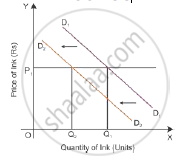
Decrease in price of complementary good:
If there is a decrease in the price of a good, then the demand for another good will increase. So the demand curve shifts parallel to the right, i.e. from D1D1 to D2D2.
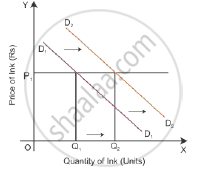
संबंधित प्रश्न
State and explain the ‘law of demand’ with its exceptions.
Market of a commodity is in equilibrium. Demand for the commodity "increases." Explain the chain of effects of this change till the market again reaches equilibrium. Use diagram.
Prices of other goods and demand for the given good.
Explain how do the following influence demand for a good:
i. Rise in income of the consumer.
ii. Fall in prices of the related goods
Good Y is a substitute of good X. The price of Y falls. Explain the chain of effects of this change in the market of X.
If with the rise in the price of good Y, demand for good X rises, the two goods are: (Choose the correct alternative)
a. Substitutes
b. Complements
c. Not related
d. Jointly demanded
How does change in the price of a substitute good affect the demand of the given good? Explain with the help of an example.
What does a rightward shift of demand curve indicate?
Define or explain the following concept.
Market Demand .
Write explanatory notes or answer the following.
Aggregate demand
Statements related to decrease in demand
- It is a type of change in demand
- It takes place due to unfavourable changes in other factors like tastes, income etc.
- Price remains constant
- Demand curve shifts to the right hand side of the original demand curve
Assertion (A): Under exceptional cases, demand curve has a positive slope.
Reasoning (R): In exceptional cases, consumer buys more when the price of a commodity rises and buys less when the price of commodity falls.
The shape of supply curve is ______
In case of perfect competition, AR curve is:
- Assertion (A): The demand curve slopes downwards.
- Reasoning (R): A fall in the price of goods increases the real income of the consumer enabling him/her to buy more.
Figures (A), (B) and (C) given below represent different types of Demand curves.
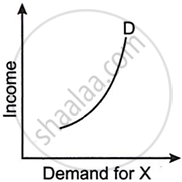 |
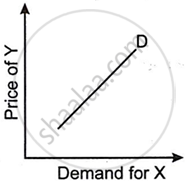 |
 |
| (A) | (B) | (C) |
What kind of goods do each of these Demand curves represent? Give a reason for each of the curves.
